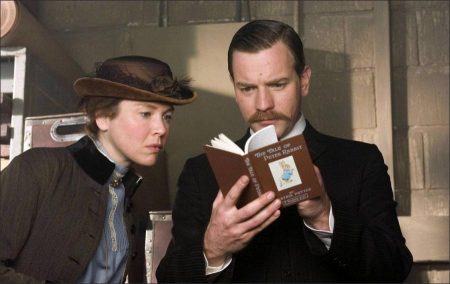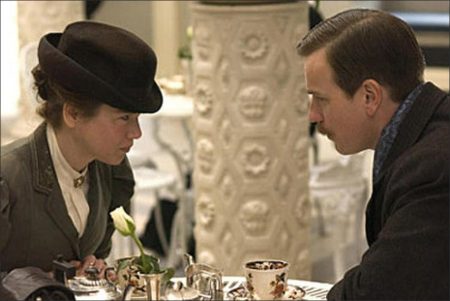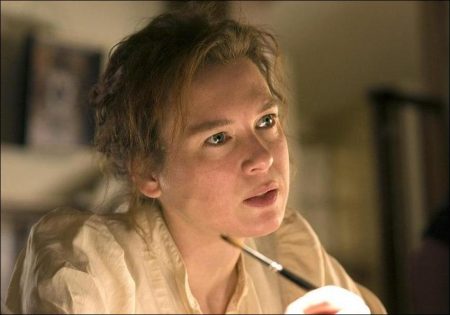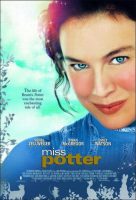Maltby’s screenplay tells Beatrix Potter’s story. It tells of her love for her publisher, Norman Warne and her striving towards an independent life at a time when her expected place in society was as a conformist wife. It praises her talented pen—both as writer and artist. It tells of a woman whose life was a fascinating mix of professional achievement and private grief. She was a woman ahead of her time.
Beatrix Potter’s conventional, social-climbing Victorian parents did not view their daughter’s adolescent stories about animals and the accompanying drawings as having particular merit. They were even less enthusiastic about her affection for a man “in trade” and hoping for a more acceptable liaison, insisted the relationship remain a secret. To her mother in particular Beatrix was a mystery and a profound disappointment. Her father shared Beatrix’ artistic bent and was a talented amateur photographer at the dawn of the new technology. A wealthy man, he was able to indulge his hobby. It is almost certain that neither parent really understood the scale of their daughter’s talent.
Producer David Kirschner recalled the process of arriving at Chris Noonan as director. “A host of directors had been interested in the project. For me, the animation and Beatrix’s imagination, and seeing the characters from the point of view of this lonely, brilliant woman was what separated the film from a traditional view of a Victorian love story to something a little different.
“I must confess Chris Noonan was not part of my original directors list, but when I heard he was interested, that was fabulous. I have probably seen BABE more times than he has—I’m the film’s biggest fan. What he has brought to the film is his gentleness, sensitivity and an element of the fantastic that is never cloying, never sentimental.”
The producers were delighted when Noonan accepted to direct MISS POTTER. They trusted his instinct and believed if anyone could tease out the marrow in Maltby’s screenplay, it was the genial Australian. Renée Zellweger recalled that it was about a year after she became involved. “I can’t remember now who suggested him, but it just seemed so right. When you read the script it’s almost impossible to believe it isn’t fiction—did this woman really lead such a colorful life of highs and lows? It’s almost Dickensian! It might go really saccharine if you chose a director who played into that melodrama. Fortunately there’s no danger of that with Chris Noonan—he underplays it all, looks for the honesty rather than playing for the drama. He always looks for the reality rather than the fairytale.
“There was a scene we were shooting one day, and I kept saying to Chris, ‘Please tell me it wasn’t corny,’ and he said, ‘Oh, no! I don’t do corny.’ There was this complete confidence from him from the get-go. It’s wonderful to work with someone who has that sort of clarity of vision because it becomes very easy. He’s probably the nicest man on the planet… he never raises his voice. At the same time he has fun and a child-like curiosity—he’s always looking around, discovering, talking to everyone. It’s the perfect partnership—the woman who created these beautiful stories that resonate with children, and Chris with his curiosity and gentle manner.”
While executive producers Nigel Wooll and Louis Phillips set to work bringing in creative technicians to meet Noonan, casting director Priscilla John started to assemble a gifted group of actors who might fit. The first choice of all concerned to play MISS POTTER’s secret sweetheart, publisher Norman Warne was Ewan McGregor. He and Zellweger worked together on DOWN WITH LOVE and thoroughly enjoyed the experience, and were actively looking for another film to do together.
McGregor, recently a celebrated Sky Masterson on the West End stage in “Guys and Dolls,” plays Obi-Wan Kenobi in George Lucas’ three prequels to STAR WARS. “Getting an actor into a role is a courtship,” explained Chris Noonan. “Ewan has the personality and charm that Norman Warne must have had. He’s playing Norman as a slightly awkward character. The chemistry between Renee and Ewan works wonderfully for the film.”
Double Oscar nominee (for BREAKING THE WAVES and HILARY AND JACKIE) Emily Watson plays Millie Warne, sister of Norman, friend and confidante of Beatrix. It is Watson’s first role since giving birth to Juliet, aged five months when filming started.
“I find it unbelievable that I have such a cast,” enthused Noonan. “I’ve always wanted to work with these actors. When I met the cast together and we discussed their characters and how they saw them, and how I saw them, I told them all that I just couldn’t believe my luck. People I’ve admired all my film going life assembled round the table… it was amazing!”
Playing MISS POTTER’s parents are two of Britain’s most consistently excellent acting talents, Barbara Flynn and Bill Paterson. Anton Lesser plays publisher Harold Warne and Phyllida Law is cast as Mrs. Warne, the publishers’ invalid mother. Lloyd Owen plays solicitor William Heelis. As the 11-year-old Beatrix there is Lucy Boynton and young Bertram is played by Oliver Jenkins. As the whole ensemble began to take shape with stellar names both in front of the camera, and behind it, critical choices were made.
Oscar winning production designer Martin Childs took up residence in the office opposite Chris Noonan at Pinewood Studios—both with their doors open, leading to a freely flowing dialogue as decisions large and small were debated.
“The first thing I do is to soak up the period, looking at contemporary paintings, and finding little clues that help. Because this story takes place in several time frames I tried to find out whether there were any handy developments in technology that we could use. Electricity was becoming commonplace in people’s homes and that enabled us to establish a different look for the interiors—when Beatrix is a child in the film, the interiors are lit by oil and gas lamp; when she is an adult, interiors can be lit by electricity.
“A similar sort of revolution was happening outside—a hundred years ago there were cars, which there were not when Beatrix was a child. Little things like that become a shorthand for establishing the period. Even the less observant viewer can pick up on the fact that there is electricity, and there are cars, not just the clip clop of horses hooves.”
Martin Childs is an enthusiast and it is no surprise that he and Chris Noonan instantly bonded into the greatest of chums as they put meat on the bones of the project. They were joined during pre-production by another great talent—the triple Oscar-winning costume designer Anthony Powell. Powell, with his genius for research came across a wonderful collection of photographs by Beatrix father, Rupert Potter, and these became a template for everything that followed.
“I’ve had enormous freedom on this film,” Anthony Powell said. “When you work with the production designer and the director it becomes like a tennis match, and you toss out ideas and bat them back and forth and after a while it’s difficult to remember who thought of what. I did huge amounts of research, not just of the Potter family, but the whole social history of the period.
“What appealed to me about the film was that I thought the script was absolutely charming, and the sort of script that doesn’t get written anymore. When I heard that Chris Noonan was going to direct it, I knew I wanted to do it because BABE is one of my all time favorite films.
“I suspect that Beatrix was very dominated by her parents for a long time until she realized her drawings had commercial value and she was earning her own money and was independent of them. I think that until that point her mother bought her clothes and she had very little say over what she wore, although when you see pictures of her even as a small child, there is an extraordinary expression of determination on that little face. You can see you could only boss her around to a certain extent.
“Beatrix’s clothes were terribly simple. I felt she cared nothing for convention or what people expected her to do or how they expected her to look. She was well brought up so obviously she wouldn’t go to a meeting with the bank manager or the publisher looking a total mess, but equally she didn’t look like the girls and women of her age.
“Renée Zellweger has tremendously strong ideas and that has made it a curious and interesting experience,” commented Anthony Powell. “I’ve gone for a contrast between the way Beatrix looked and the way other women looked. In the late 19th century and early 20th century it was the full flowering of the belle epoch. Women tended on the whole to be overdressed, over coifed, over hatted, and I’ve tried to make that point.”
Powell says that every film has its challenges and his job is finding solutions. Fortunately he had the resources of John Bright and his company Cosprop who have a unique collection of antique clothes and copies, the quality of which is such that you really can’t tell what is antique and what is a copy. “In many cases if they are original 19th century clothes they are too fragile to use, but they can be used for inspiration,” he said. “I managed to get a huge amount from stock and we have made lots of things. Because Cosprop has such a huge diversity of stock you can usually match your vision pretty closely. When I first talked to Chris Noonan I said I would like the film to have a documentary quality rather than a designer quality.”
With the selection of production designer and costume designer made, Chris Noonan chose Andrew Dunn as his director of photography. Dunn is a quietly authoritative figure whose previous films include THE MADNESS OF KING GEORGE for Nicholas Hytner, STAGE BEAUTY for Richard Eyre, GOSFORD PARK for Robert Altman and MRS. HENDERSON PRESENTS for Stephen Frears. Noonan’s choice of editor is Robin Sales who worked on many of the Richard Sharpe action films for television before making the break into movies with Mike Leigh’s lavish TOPSY-TURVY, about Gilbert and Sullivan, and JOHNNY ENGLISH.
Executive producer Nigel Wooll, one of the most experienced producers in the British film industry, steeped in the challenge of eliminating slack in a budget while never sacrificing quality, set in motion the parameters for the production. Having had a successful experience working in the Isle of Man during 2005 with his film KEEPING MUM, Nigel, following discussions with Louis Phillips decided to repeat the experience with MISS POTTER. The island—while playing no actual part in the story—provided interior locations and a sizeable portion of the budget.
Martin Childs and his construction crew faced the awesome task of building the sets for MISS POTTER within sheds in the middle of Isle of Man fields. Sound stages at studios they were not, but Childs’ team rose to the challenge and out of horizontal rain, sleet, snow and mud, gradually the Potter home emerged.
“At the risk of sounding negative there is always one set of circumstances that is different from the rest,” recalled Martin Childs “With MISS POTTER it was, ‘let’s shoot the film in the Isle of Man rather than on sound stages.’ I designed the sets I wanted and the challenge for the art director was to fit those designs into the barns they found in the middle of fields… We got there in the end, but it makes you realize how much you take for granted in a real film studio on a real sound stage.”
MISS POTTER commenced principal photography March 7, 2006. In the first two weeks of production, the cast and crew moved at a brisk pace around London and the Home Counties.
“The key to transforming London is road surfaces,” commented Martin Childs. “In order to make it look acceptable we actually made road surfaces older than historically accurate. Apart from that, we generally found parts of London without too many parking meters. Most of the buildings we are using are protected or private, so they look right.”
Thus The Reform Club, situated at the heart of ceremonial London, is cast as itself when Norman goes to ask Mr. Potter for his daughter’s hand in marriage. The Club is also transformed as a bank, for a scene where Beatrix asks her bank manager if she can afford to buy a property in the Lake District. The famous Bluebell Railway where the age of steam lives on, if only for tourists, was home to the unit for three days for a poignant farewell scene as the Potters leave London for the Lake District, and Beatrix said goodbye to Norman Warne.
“The Bluebell Railway has no similarity to Euston Station in London, which is where the Potters would have left for the Lake District,” explained Martin Childs. “You can’t achieve what we were trying to achieve in a big, urban railway station—there are too many people, too much going on, and too many shop fronts to hide. So we went to the Bluebell Railway where there are some good, period trains and we just shot as close as we could, and as wide as we dared, and used a heck of a lot of smoke and steam and rain! We put in a few buildings to block out the countryside. It’s a sweet, rural station and that is its charm…”
The production, inevitably, worked hand in glove with the National Trust, using many of their houses, and much of their land. Thanks to that organization and the film offices in Cumbria and the Isle of Man, meticulous planning, attention to detail, and goodwill meant that no serious request was denied the filmmakers.
The National Trust’s Osterley House provides three excellent locations in one venue—as Hyde Park complete with horses and carriages, as an art gallery visited by Beatrix and Millie Warne, and as a tearoom where Beatrix and Norman speculate about how much profit Beatrix’s books might make. Traditional London Squares in Lincoln’s Inn and Hammersmith provided the frontage for solicitors’ establishments and the exterior of the Potter home. Fake snow, carriages and the clip clop of hooves completed the illusion of a bygone age, and residents emerged with their digital cameras to record the moment when Hollywood created movie magic.
A magnificent street of Queen Anne houses, surprisingly sited in a less than salubrious West London suburb, provided the exterior of the Warne home, while Kingston-upon-Thames offered up a fabulous period conservatory for the Warne garden for a scene where Beatrix takes tea with Mrs. Warne, Norman and Millie Warne. She and Millie decide there and then to become best friends.
One of the most memorable days was the one spent at the Type Museum for a scene where Beatrix goes with Norman Warne to visit the printers and see the first copy of “The Tale of Peter Rabbit” come off the presses. The Type Museum has been conceived as a working museum of the word. Its collections span the whole history of type making and printing.
Real printers who operate the old printing presses for the demonstrations held at the Museum, were cast as printers in the film. One of them had actually been apprenticed with Frederick Warne & Co, publishers of Beatrix Potter’s books.
The Museum houses arguably the most comprehensive collection of type and printing presses in the world. Among their valued items is the original type used for the first printing of the Declaration of Independence (1776). The Museum’s archives span 400 years of printing and if it wasn’t for materials held in these archives 95% of the books and magazines in the world would not exist.
But the heart and soul of the film, is the Lake District and it was there that the final two weeks location took place, providing a fitting climax to an epic journey. Beatrix Potter spent much of her life in the Lake District, arguably the most contented part of that life. She left her land and property to the National Trust, and it was they who paved the way for the film using properties owned by Beatrix Potter for the film.
In fact her first home, Hill Top, was not suitable for filming, so another of her properties, Yew Tree, was substituted. Martin Childs explained: “Hill Top is fabulous but it’s a very well known place attracting tourists from all over the world. Not only is it full of tourists but the National Trust could not close it down for the length of time it would take to shoot scenes there.”
Yew Tree was transformed into Hill Top—a dry stone wall was built, a prolific kitchen garden was planted, the cottage was washed with a very natural pale sand color, a porch was built round the front door and glazing bars were added to the windows.
The National Trust was extremely helpful and after initial consultation, permissions were forthcoming. The tenants who live at Yew Tree and put up with having a film crew on their doorstep for weeks on end, were so entranced with the dry stone wall that they want to keep the cottage looking as it did during the filming.
“It’s great for me,” said Martin Childs. “I trained as an architect and that dry stone wall is the first real building I’ve ever done. Everything else has been dumped on a skip at the end of filming.”
The Lake District fulfilled its promise as a magical location. And at last, the sun came out, bathing the proceedings in golden light. It became easy to see why Beatrix Potter herself found peace in the lakes and valleys of this loveliest of English regions.
As Renée Zellweger said, “Beatrix Potter was a great naturalist and a brilliant woman. She was such a smart woman, so clever, multi-faceted. And yet, not many people know about her.” All that is about to change.
Miss Potter (2007)
Directed by: Chris Noonan
Starring: Renée Zellweger, Ewan McGregor, Emily Watson, Barbara Flynn, Bill Paterson, Lloyd Owen, Anton Lesser, David Bamber, Patricia Kerrigan, Lucy Boynton, Justin McDonald
Screenplay by: Richard Maltby, Jr.
Production Design by: Martin Childs
Cinematography by: Andrew Dunn
Film Editing by: Robin Sales
Costume Design by: Anthony Powell
Set Decoration by: Tina Jones
Art Direction by: Grant Armstrong, Mark Raggett
Music by: Nigel Westlake
MPAA Rating: PG for brief mild language.
Studio: Metro Goldwyn Mayer
Release Date: March 9, 2007
Visits: 67






